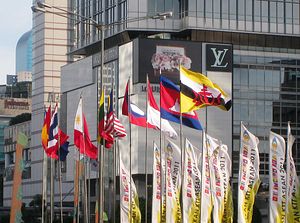The reluctance of the Myanmar government to seek external assistance in dealing with the Rohingya crisis is reminiscent of the initial recalcitrance of the military dictatorship of Senior General Than Shwe in the aftermath of the devastation of Cyclone Nargis in May 2008. Although over 130,000 in Myanmar’s delta townships perished in that disaster, the Myanmar junta at first refused to accept most of the external offers of emergency humanitarian assistance.
The delays and inability of the Myanmar junta to provide timely emergency assistance caused additional deaths and sufferings. Some Western governments accused the Myanmar military leadership of failing in its government responsibility to protect citizens. Some even mentioned the possibility of doing unilateral “humanitarian intervention” by air dropping food and other aid supplies in the disaster areas. Some Myanmar military leaders were concerned that an influx of foreign aid workers could interfere in the national referendum of a new constitution on May 10, 2008.
The dire situation prompted the ASEAN foreign ministers to convene an emergency meeting in Singapore on May 19, 2008. At the meeting, in which the author was present as a special assistant to ASEAN Secretary-General Dr. Surin Pitsuwan, the ASEAN foreign ministers asked Myanmar Foreign Minister Nyan Win to consider three options: coping with the humanitarian crisis alone and facing the intensifying wrath of the international community if delays persisted; opening up to working with the UN and the international community; or involving as well ASEAN in international concerted efforts to save lives in the disaster areas.
After reporting back to Nay Pyi Taw, the foreign minister of Myanmar soon returned to the meeting with a breakthrough good news: the Myanmar military government wanted to involve all, including ASEAN. Subsequently, ASEAN successfully teamed up with the Ministry of Foreign Affairs of Myanmar and the UN in organizing coordinated massive international humanitarian assistance for the cyclone survivors.
Now in the wake of the Rohingya crisis, the Myanmar government should refresh memories of lessons learned from Cyclone Nargis.
Hiding behind the obsolete narrow interpretation of non-interference is again not tenable. Over 10,000 Rohingya have fled to seek sanctuary in Bangladesh border areas in recent weeks of violence. More may follow suit. Others might risk their lives by fleeing on unsafe boats to Thailand, Malaysia, and Indonesia.
Muslims in Malaysia and Indonesia have raised vehement hues and cries against what they believe to be “ethnic cleansing” against Rohingya Muslims in Myanmar’s Rakhine state. Last Sunday Malaysian Prime Minister Naijb Razak joined a gathering in Kuala Lumpur to call urgent international attention to the plight of the Rohingya. Like it or not, the Rohingya crisis is an international concern.
Unfortunately the Myanmar government considers the Rohingya as “Bengalis” and “illegal migrants.” It even objects to calling them “Rohingya”; no such ethnic minority group is recognized under the law or the constitution of the country. Daw Aung San Suu Kyi, during her official visit to Singapore last week, wouldn’t say anything in public about the crisis. She also doesn’t like the name “Rohingya.”
Clearly the government under her NLD leadership is incapable of coping with the Rohingya crisis, partly because a majority of Buddhists in Myanmar don’t empathize with the Rohingya. Some senior Buddhist monks have even campaigned to expel the Rohingya out of the country — no compassion whatsoever from these Buddhist monks. A new commission set up to investigate the recent flare-ups of violence against the Rohingya may not be able to recommend any new solutions.
This is why the Myanmar government must look into new ideas and pragmatic solutions. Obviously, cooperation with the UN and the international community to at least stop the violence is a sensible option.
Better yet, the Myanmar government can involve ASEAN, just like in the case of Cyclone Nargis eight years ago. ASEAN has the organizational know-how, international connections, and resource mobilization experience. ASEAN can once again build a bridge for Myanmar and the international community to save lives in Myanmar.
In fact, all other ASEAN member governments are duty-bound to offer their assistance to the Myanmar government. This is what community-building in the spirit of caring and sharing is all about. A people-centered ASEAN Community must empathize with the plight of the Rohingya, regardless of whether they are illegal migrants or stateless people. For they are helpless human beings in distress in one corner of our regional community.
ASEAN’s credibility and centrality are directly at stake here should ASEAN member governments continue to shy from offering the assistance. They cannot pretend to be oblivious of the suffering of these human beings.
Offering assistance must not be mistaken as interfering in the domestic affairs of Myanmar. This is part of the collective responsibility in ASEAN to maintain and enhance regional peace, security, and prosperity, as well as promote the well-being of all peoples in the ASEAN Community.
The Myanmar government’s response to such an offer of ASEAN assistance will reveal its true attitude toward ASEAN membership and the ASEAN community spirit.
Dr. Termsak Chalermpalanupap is a fellow at the ISEAS-Yusof Ishak Institute and lead researcher on ASEAN political and security affairs at the Institute’s ASEAN Studies Centre.

































